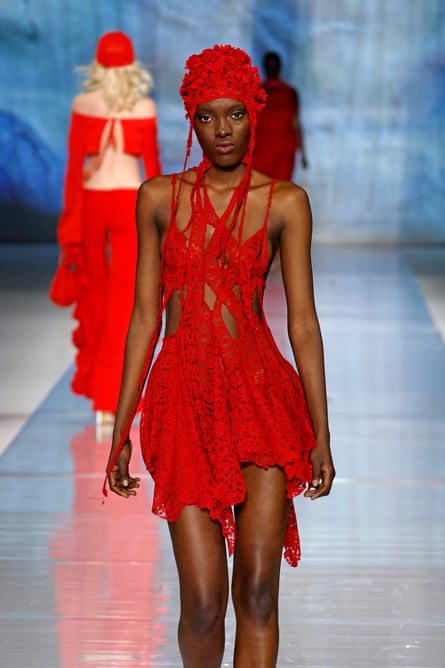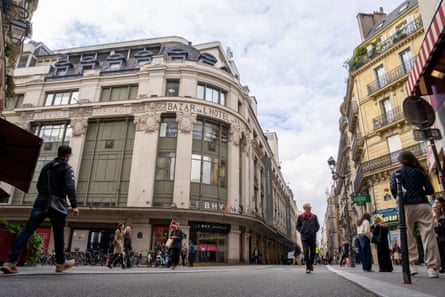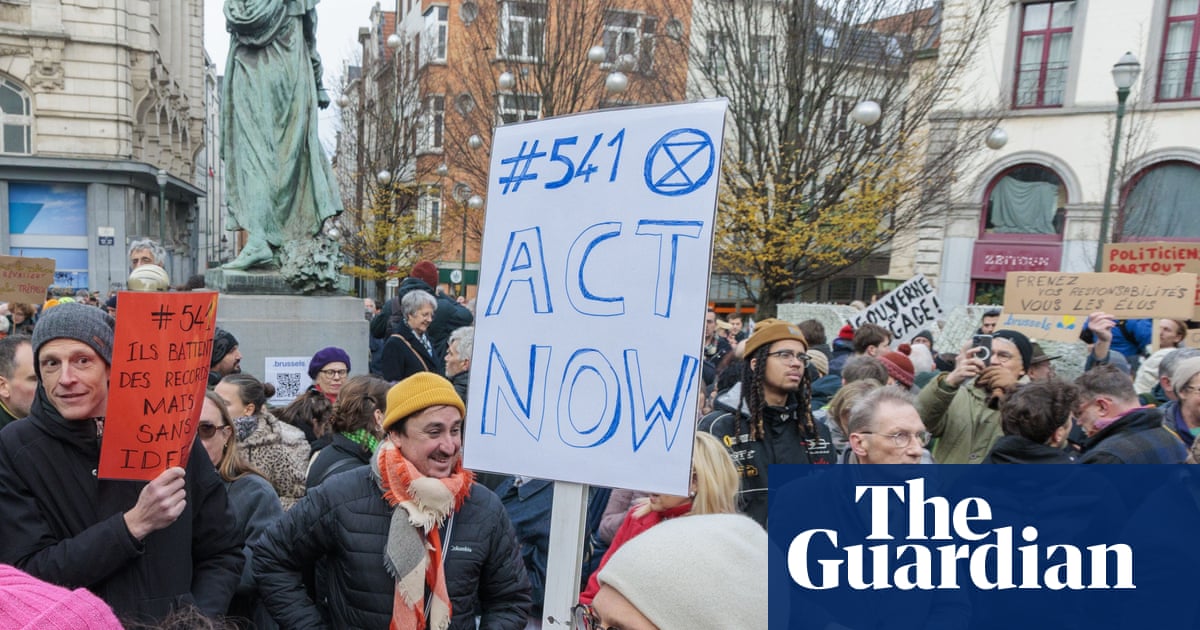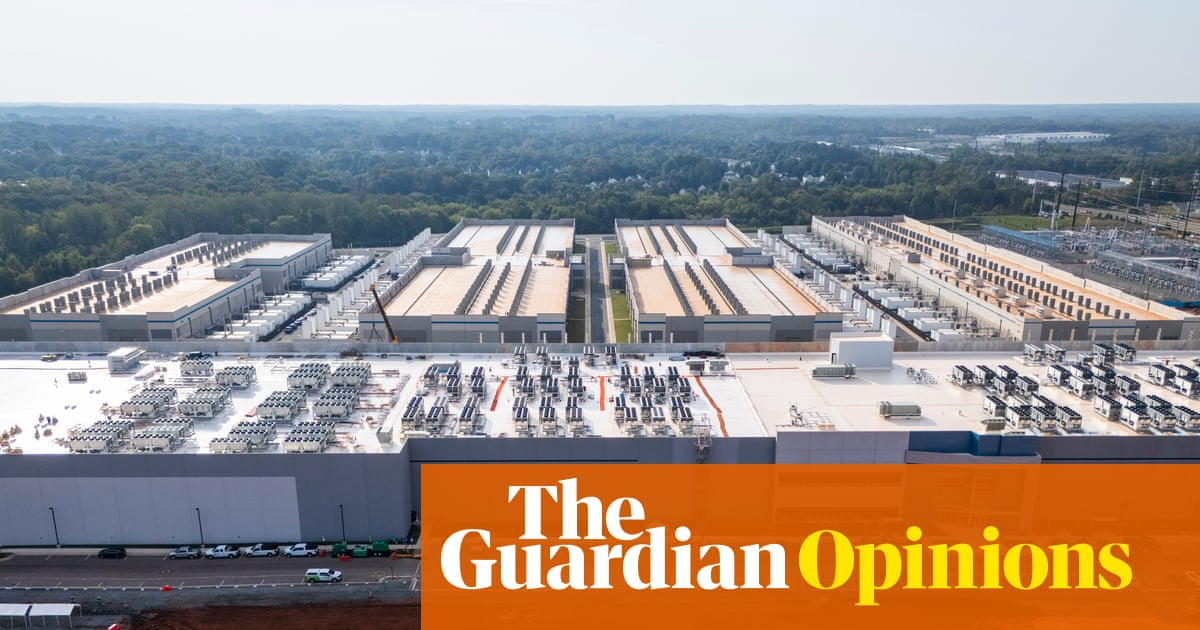A couple of hours before Shein opened a pop‑up shop in Dijon this summer, the words “Shein kills” and “exploitation, forced labour, slavery, pollution” were found graffitied in French on the outside wall.
Yet the fierce backlash to its series of temporary outlets in France in recent years, including in Toulouse, Montpellier and Marseille, has not deterred the Chinese-founded fast fashion brand from choosing the country for its first permanent physical stores.
This week it announced a plan to open shops in Galeries Lafayette department stores in five cities and also in the BHV store in the capital.
“In front of the Paris City Hall, they are creating the new Shein megastore, which – after destroying dozens of French brands – aims to flood our market even more massively with disposable products,” said Yann Rivoallan, head of the fashion retailers’ body Fédération Française du Prêt à Porter Féminin.
Sophie Abriat, author and fashion reporter for Le Monde’s magazine M, says: “The ultra-fast model is a paroxysm of disposability. It is built with ephemerality, with aggressive marketing.”
But, she adds, France’s distaste for the trend goes even deeper: “It differs from French culture’s tradition of keeping objects, of savoir-faire – Shein holds a stigma that is moral as well.”
Yet despite such outspoken antipathy, with a Change.org petition to ban Shein in France now having topped 270,000 signatures, the country has not been immune to the brand’s inexorable rise over the past five years.
Its model, based on shipping orders of cheap clothes directly from Chinese factories to homes, reportedly brought in $1bn net profit last year, making it not simply a figurehead of “ultrafast fashion”, but one of its most lucrative companies. That is despite criticism over its environmental impact and working practices, including allegations of forced labour that the company has denied and cases of child labour that led to supplier contracts being terminated.
Its success rests with the mind-boggling speed and volume with which it can produce designs, with 7,200 new items listed on the site every day. “It marks an entirely new way of consuming – everything is multiplied by a hundred,” says Abriat. Between late 2022 and late 2023, the company introduced 1.5m products to the US market – roughly 37 times more than Zara and 65 times more than H&M, according to Reuters.

Around the time of the Dijon pop-up opening, the French senate approved legislation aimed at curtailing ultra-fast fashion, specifically platforms like Shein and its ultra-low cost shopping rival Temu. It proposed a range of measures, from eco-taxes to a ban on advertising, restrictions on influencer collaborations, mandatory disclosure of production practices, and redirection of taxed revenues towards French sustainable producers.
The bill was praised by many as a step in the right direction, but raised eyebrows for distinguishing between so-called “classical” fast fashion (Zara, H&M among others), and “ultra-fast fashion”. Indeed, the former group faces less stringent constraints. For some, this distinction seems to make high-street labels appear more virtuous by comparison, despite similar supply chains; for others, it is simply regarded as a way of undercutting Chinese competition.
Yet France has its own history of fast fashion, rooted in the Sentier, Paris’s historic garment district in the 2nd and 3rd arrondissements. From the 1970s onward, the quartier, alongside other such wholesale districts (including in Marseille), developed a model based on rapid turnaround, small quantities, and short supply circuits, often replenished on demand rather by seasonal calendars.
This fuelled the rise of cult – and affordable – homegrown high street labels such as Naf Naf, Kookaï, and Jennyfer, which thrived through the 1980s and 1990s, both in France and abroad, before outsourcing production and eventually disappearing or repositioning themselves. By the late 20th century, the Sentier’s system was outpaced by international labels such as H&M and Zara, who delocalised production and scaled up sourcing and stock – a dynamic portrayed in the French film saga La Vérité si je mens! (Would I Lie to You?), which is set in the area.
On a cultural level, Abriat compares Shein’s reception to that of the early days of H&M when it arrived on Paris’s rue de Rivoli in 1998: “It was considered vulgar. The fashion elite saw it [as] devoid of taste or culture.” Today, she says, “they have been worked into actual labels, fully accepted” while Shein has taken on the pariah role.
Attracting teenagers, H&M radically shifted its image with Karl Lagerfeld’s collaboration in 2004, which sold out within hours. From then on, France’s fashion establishment began to accept high-street pieces as part of the contemporary Parisian wardrobe.
Other fast-fashion megabrands sought credibility by working tightly with renowned industry names. Emmanuelle Alt, former editor-in-chief of Vogue Paris, worked with Zara as a creative consultant, while Suzanne Koller, co-founder of Self Service magazine and current fashion editor at M le Magazine du Monde, has collaborated extensively with the brand, around fashion direction and styling. Model and Chanel ambassador Caroline de Maigret walked in an H&M runway show. and French model Aymeline Valade has appeared in a Zara lookbook and openly told W magazine that she shops there, for basics at least.
Sophie Fontanel, writer, influencer, and fashion editor at L’Obs, says: “Here in Paris, it has become common to mix Zara, vintage, and luxury, all with a certain knowhow. Parisians don’t go to Zara for statement pieces or counterfeits, but for basics: shirts, jeans, timeless staples.” Few admit to actually wearing the brand in daily life, however. “You don’t say it,” says Fontanel. “Or you say: ‘You won’t believe it, but it’s Zara.’”
A key difference with Shein is its online presence, which represents a cultural shift for older generations of shoppers. French-British influencer and writer Camille Charrière, says: “The French still like to shop in stores, with their friends and family, on the weekend. They don’t change outfits radically to go out on the weekend or at night, their purchases are less compulsive.”

Part of the appeal of ultra fast fashion lies in its size inclusivity: for many consumers, it remains the only brand that caters to diverse body types. The plus-size market is still virtually non-existent in France, particularly among mid- and high-end labels.
Ultra-fast fashion has also introduced new ways of consuming: online shopping, skipping fittings, and bulk ordering. Garments are often worn once, thrown out or resold on secondhand platforms – a drastic shift in pace, durability, and building a wardrobe.
Charrière stresses that there can be a “slow” way of wearing fast fashion: “One shouldn’t torture oneself about wearing fast fashion. I have Zara dresses from five years ago that I still wear. To me the most important thing is to force myself to use what I buy … to commit to wearing it.” While that doesn’t change the supply chain it came from, Charrière may have a point: shaming Shein customers often overlooks the privilege of being able to afford more expensive alternatives.
Shein has seized on that tension. In April it plastered slogans such as “Fashion is a right, not a privilege” across billboards and ads. Christophe Castaner – the former interior minister and ex-president of Emmanuel Macron’s party, now head of Shein France’s communication – accused lawmakers of punishing low-income shoppers with what he called “a VAT on the products of the poorest”, adding “personally, I find that pretty disgusting”.
Shein has previously said in response to reports of labour abuses that it works “tirelessly to ensure that these isolated cases are removed from our supply chain entirely”.
For Elise Goldfarb, consultant and professor at the Institut Français de la Mode and an active voice in denouncing the use of Uyghur forced labour in fast fashion supply chains, the phenomenon has also shed light on the reality of another segment of French society. “Fast fashion speaks to a segment of the population for whom it feels outrageous to be lectured about ecology during a major crisis they are paying for,” she says.
Taxation and regulation may be a useful first step, but they leave the core problem of overproduction untouched. The real question is how the industry can be reshaped around durability and repair, clothes that can be passed from one generation to the next, kept, repaired, once so central to the French approach.
“It’s like a flood of information with no attachment, everything interchangeable.”, says Stéphane Popescu, co-founder of a consultancy specialising in ethical fashion. “I see mountains of ultra fast fashion clothing in vintage stores, and it feels as if the emotional value of things has disappeared, like there’s no time to build memories around items.”

 2 months ago
67
2 months ago
67

















































